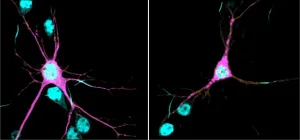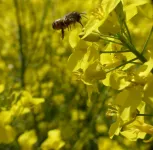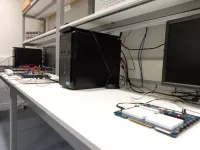(Press-News.org) CHAPEL HILL, NC - Scientists at the University of North Carolina at Chapel Hill School of Medicine and colleagues have demonstrated that variants in the SPTBN1 gene can alter neuronal architecture, dramatically affecting their function and leading to a rare, newly defined neurodevelopmental syndrome in children.
Damaris Lorenzo, PhD, assistant professor in the UNC Department of Cell Biology and member of the UNC Neuroscience Center at the UNC School of Medicine, led this research, which was published today in the journal Nature Genetics. Lorenzo, who is also a member of the UNC Intellectual and Developmental Disabilities Research Center (IDDRC) at the UNC School of Medicine, is the senior author.
The gene SPTBN1 instructs neurons and other cell types how to make βII-spectrin, a protein with multiple functions in the nervous system. Children carrying these variants can suffer from speech and motor delays, as well as intellectual disability. Some patients have received additional diagnosis, such as autism spectrum disorder, ADHD, and epilepsy. Identification of the genetic variants that cause this broad spectrum of disabilities is the first important milestone to finding treatments for this syndrome.
Lorenzo first learned about patients with complex neurodevelopmental presentations carrying SPTBN1 variants from Queenie Tan, MD, PhD, a medical geneticist, and Becky Spillmann, MS, a genetic counselor - both members of the NIH-funded Undiagnosed Disease Network (UDN) site at Duke University and co-authors of the Nature Genetics paper. They connected with Margot Cousin, PhD, a geneticist associated with the UDN site at the Mayo Clinic and co-first author or the study. Cousin had also collected clinical information from SPTBN1 variant carriers. Other clinical genetics teams learned about these efforts and joined the study.
The cohort of individuals affected by SPTBN1 variants continues to grow. Lorenzo and colleagues have been contacted about new cases after they published a preprint of their initial findings last summer. Identifying the genetic cause of rare diseases such as the SPTBN1 syndrome requires pooling knowledge from several patients to establish common clinical and biological patterns.
"Fortunately, the advent of affordable gene sequencing technology, together with the creation of databases and networks to facilitate the sharing of information among clinicians and investigators, has vastly accelerated the diagnosis of rare diseases," Lorenzo said. "To put our case in historical perspective, βII-spectrin was co-discovered 40 years ago through pioneering work that involved my UNC colleagues Keith Burridge, PhD, and Richard Cheney, PhD, as well as my postdoctoral mentor Vann Bennett, PhD, at Duke. However, its association with disease eluded us until now."
βII-spectrin is tightly associated with the neuronal cytoskeleton - a complex network of filamentous proteins that spans the neuron and plays pivotal roles in their growth, shape, and plasticity. βII-spectrin forms an extended scaffolding network that provides mechanical integrity to membranes and helps to orchestrate the correct positioning of molecular complexes throughout the neuron. Through research published in PNAS in 2019, Lorenzo found that βII-spectrin is essential for normal brain wiring in mice and for proper transport of organelles and vesicles in axons - the long extensions that carry signals from neurons to other neurons. βII-spectrin is an integral part of the process that enables normal development, maintenance, and function of neurons.
In this new study, Lorenzo's research team showed that, at the biochemical level, the genetic variants identified in patients are sufficient to cause protein aggregation, aberrant association of βII-spectrin with the cytoskeleton, impair axonal organelle transport and growth, and change the morphology of neurons. These deficiencies can permanently alter how neurons connect and communicate with each other, which is thought to contribute to the etiology of neurodevelopmental disorders. The team showed that reduction of βII-spectrin levels only in neurons disrupts structural connectivity between cortical areas in mutant mice, a deficit also observed in brain MRIs of some patients.
In collaboration with Sheryl Moy, PhD, professor in the UNC Department of Psychiatry and director of the Mouse Behavioral Phenotyping (MBP) Core of the UNC IDDRC, the researchers found that these mice have developmental and behavioral deficits consistent with presentations observed in humans.
"Now that we've established the methods to assign likelihood of pathogenicity to SPTBN1 variants and to determine how they alter neurons, our immediate goal is to learn more about the affected molecular and cellular mechanisms and brain circuits, and evaluate strategies for potential clinical interventions," Lorenzo said.
To this end, her team will collaborate with Adriana Beltran, PhD, assistant professor in the UNC Department of Genetics and director of the UNC Human Pluripotent Cell Core, to use neurons differentiated from patient-derived induced pluripotent stem cells. And the research team will continue to tap into molecular modeling predictions in collaboration with Brenda Temple, PhD, professor in the UNC Department of Biochemistry and Biophysics and director of the UNC Structural Bioinformatics Core, both co-authors on the Nature Genetics paper.
"As a basic science investigator, it's so satisfying to use knowledge and tools to provide answers to patients," Lorenzo said. "I first witnessed this thrill of scientific discovery and collaborative work as a graduate student 15 years ago when our lab identified the genetic cause of the first spectrinopathy affecting the nervous system, and it has been a powerful motivator since."
That work was the discovery of variants in a different spectrin gene as the cause of spinocebellar ataxia type 5 (SCA5), led by Laura Ranum, PhD, who at the time was at the University of Minnesota. In follow up work, as part of that team, Lorenzo contributed insights into the pathogenic mechanism of SCA5.
"Aside from the immediate relevance to affected patients, insights from our work on SPTNB1 syndrome will inform discoveries in other complex disorders with overlapping pathologies," Lorenzo said. "It is exciting to be part of such important work with a team of dedicated scientists and clinicians."
INFORMATION:
Members of the Lorenzo lab who are co-authors in the Nature Genetics paper are co-first author Blake Creighton, lab research technician in the Lorenzo lab; Reggie Edwards, graduate student; Keith Breau, graduate student at the time of this research; Deepa Ajit, PhD, a postdoctoral fellow; Sruthi Dontu, Simone Afriyie, and Julia Bay, all undergraduates at UNC-Chapel Hill; and Liset Falcon, lab research technician at the time of this research. Other UNC-Chapel Hill collaborators and co-authors in the paper are Kathryn Harper, PhD, project manager in the MBP Core; and Lorena Munoz and Alvaro Beltran, both research associates in the hHPSC.
Hundreds of genetic drivers affect sexual and reproductive behaviour
Combined with social factors, these can affect longevity and health
An Oxford-led team, working with Cambridge and international scholars, has discovered hundreds of genetic markers driving two of life's most momentous milestones - the age at which people first have sex and become parents.
In a paper published today in Nature Human Behaviour, the team linked 371 specific areas of our DNA, called genetic variants (known locations on chromosomes), 11 of which were sex-specific, to the timing of first sex and birth. These variants interact with environmental factors, such as socioeconomic status and when you were born, and are predictors of longevity and later life disease.
The researchers ...
People who have lost their sense of smell are being failed by healthcare professionals, new research has revealed.
A study by Newcastle University, University of East Anglia and charity Fifth Sense, shows poor levels of understanding and care from GPs and specialists about smell and taste loss in patients.
This is an issue that has particularly come to the forefront during the Covid-19 pandemic as many people who have contracted the virus report a loss of taste and smell as their main symptoms.
Around one in 10 people who experience smell loss as a result of Covid-19 report that their sense of smell has ...
In a new publication from Opto-Electronic Advances; DOI 10.29026/oea.2021.210040, Researchers led by Professor Daewook Kim from The University of Arizona, Tucson, AZ, USA consider advances in optical engineering for future telescopes.
Astronomical advances are largely coupled with technological improvements - from the invention of the first optical telescope used by Galileo in 1609 and for the foreseeable future, astronomy and optical engineering will be forever linked. This paper summarizes several advances that will enable future telescopes to expand scientific understanding of the universe. Significant optical engineering advances at the University of Arizona are being made for design, fabrication, and construction of next ...
BLOOMINGTON, Ind. -- Scientists at Indiana University have found that significant amounts of the two main components of cannabis, THC and CBD, enter the embryonic brain of mice in utero and impair the mice's ability as adults to respond to fluoxetine, a drug commonly used to treat anxiety and depression and known by the brand name Prozac.
The study suggests that when the developing brain is exposed to THC or CBD, normal interactions between endocannabinoid and serotonin signaling may be diminished as they become adults.
"Hemp-derived CBD is a legal substance in the U.S., and we are in a time of increasing state-level legalization of cannabis. ...
A team of researchers from the University of Cambridge, University College London, University of Oxford, and University of Brescia/RFF-CMCC European Institute on Economics and the Environment carried out the first systematic analysis of the relative performance of probabilistic cost forecasts from expert-based methods and model-based methods.
They specifically focused on one expert-based method -- expert elicitations -- and four model-based methods which model costs either as a function of cumulative installed capacity or as a function of time. The results of this ...
Researchers have developed a more efficient platform for studying proteins that play a key role in regulating gene expression. The approach uses engineered yeast cells to produce enzyme and histone proteins, conduct biochemical assays internally, and then display the results.
"Biomedical and biotech researchers are interested in the mechanisms that allow histones to regulate gene activity," says Alison Waldman, first author of a paper on the work and a Ph.D. student at North Carolina State University. "But the conventional tools for histone research are unwieldy ...
Mass-flowering crops such as oilseed rape or faba bean (also known as broad bean) provide valuable sources of food for bees, which, in turn, contribute to the pollination of both the crops and nearby wild plants when they visit. But not every arable crop that produces flowers is visited by the same bees. A team from the University of Göttingen and the Julius Kühn Institute (JKI) in Braunschweig has investigated how the habitat diversity of the agricultural landscape and the cultivation of different mass-flowering crops affect wild bees. The research shows that diverse agricultural landscapes increase the species richness ...
A team led by Skoltech professor Artem R. Oganov studied the structure and properties of ternary hydrides of lanthanum and yttrium and showed that alloying is an effective strategy for stabilizing otherwise unstable phases YH10 and LaH6, expected to be high-temperature superconductors. The research was published in the journal Materials Today.
Cuprates had long remained record-setters for high-temperature superconductivity until H3S was predicted in 2014. This unusual sulfur hydride was estimated to have high-temperature superconductivity at 191-204 K and was later obtained experimentally, setting a new record in superconductivity.
Following this discovery, many scientists turned to superhydrides, which are abnormally rich in hydrogen, and discovered new compounds that ...
Laboratories are an inherent part of technology qualifications, as practical experiments are essential for students to acquire the competencies and skills that they will need during their future professional development. Providing this learning in a virtual format is one of the challenges posed by the current COVID-19 pandemic--a challenge that distance universities have been addressing for years. RLAB-UOC is a remote laboratory designed and developed by the Universitat Oberta de Catalunya (UOC) that enables students in the Faculty of Computer Science, Multimedia and Telecommunications to conduct practical experiments with real electronic and communications equipment anywhere, at any time. A new article published in the scientific journal Electronics has described the characteristics ...
Near-death experiences are known from all parts of the world, various times and numerous cultural backgrounds. This universality suggests they may have a biological origin and purpose, but exactly what this could be has been largely unexplored.
A new study conducted jointly by the University of Copenhagen (Denmark) and the University of Liege (Belgium) and published in Brain Communications shows how near-death experiences in humans may have arisen from evolutionary mechanisms.
"Adhering to a preregistered protocol, we investigated the hypothesis that thanatosis is the evolutionary origin of near-death experiences", says Daniel Kondziella, a neurologist from Rigshospitalet, Copenhagen University Hospital.
When attacked by a predator, as a last resort defense mechanism, ...



